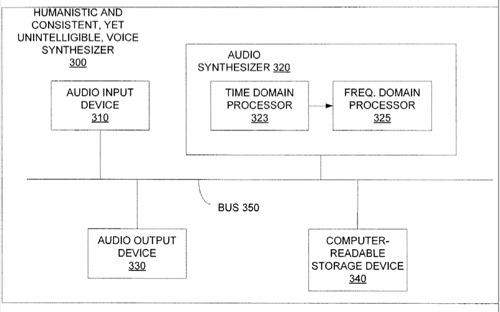Two Apple patents at the US Patent & Trademark Office show that Apple wants to make it easier to adjust audio playback controls on the Mac — and make using audio more fun.
Patent number 20110010626 involves a device and method for adjusting a playback control with a finger gesture. The disclosed embodiments relate generally to electronic devices with touch-sensitive surfaces that provide media content (e.g., music and/or video content). More particularly, the disclosed embodiments relate to adjusting a playback control with a finger gesture on a touch-sensitive surface of an electronic device.
In some embodiments, a method is performed at an electronic device with a touch-sensitive surface while the device is providing content. The device detects a finger contact at a first location on the surface. The first location and an edge of the surface define a first distance. The finger contact at the first location corresponds to a start of a control adjustment gesture for setting an adjustable parameter for providing content. In response to detecting the start of the control adjustment gesture, the device maps a range of positions associated with the adjustable parameter to correspond to at least a portion of the first distance; detects movement of the finger contact in the control adjustment gesture; and modifies the adjustable parameter for providing content in accordance with the movement of the finger contact in the control adjustment gesture and the mapping of the range of positions. The inventors are Jorge Fino, Benjamin Andrew Rottier and Policarpo Wood.
Here’s Apple’s background on the invention: “The use of touch-sensitive surfaces as input devices for computers and other electronic computing devices has increased significantly in recent years. Exemplary touch-sensitive surfaces include touch pads and touch screen displays. Such surfaces are widely used to manipulate content that is provided on electronic devices.
“Concurrently, electronic devices for providing or playing media content, including video, television programs, movies, etc., as well as audio recordings of all types (e.g., podcasts, music, lectures, audio-books, etc.) have become quite popular in recent years. These devices generally include controls to adjust content playback parameters such as volume, balance, treble, bass, screen brightness, etc. Sometimes these controls are physical buttons on the electronic device. Sometimes these controls are displayed on a screen, such as a touch screen display. Playback controls may be adjusted in a number of different ways, e.g., with physical buttons, via direct manipulation of the control on a touch screen, etc.
“But existing methods for adjusting playback controls are cumbersome and inefficient. For example, navigating and manipulating a large number of playback controls, menus, or options is tedious and creates a significant cognitive burden on a user, particularly for handheld electronic devices. In addition, existing methods take longer than necessary, thereby wasting energy. This latter consideration is particularly important in battery-operated devices.
“Accordingly, there is a need for electronic devices with faster, more efficient methods and interfaces for adjusting playback parameters on electronic devices. Such methods and interfaces may complement or replace existing playback control methods. Such methods and interfaces reduce the cognitive burden on a user and produce a more efficient human-machine interface. For battery-operated devices, such methods and interfaces conserve power and increase the time between battery charges.”
Patent number 20110010179 — the “fun” patent — is for voice synthesis and processing. It involves voice synthesis and processing, and, more particularly, to synthesizing humanistic and consistent, but unintelligible, voices. In other words, you’ll be able to use your Mac’s microphone to create the voices of “aliens, monsters, robots, animals.”
A method and an apparatus for voice synthesis and processing are presented in the patent. In one exemplary method, a first audio recording of a human speech in a natural language is received. Then speech analysis synthesis algorithm is applied to the first audio recording to synthesize a second audio recording from the first audio recording such that the second audio recording sounds humanistic and consistent, but unintelligible. Devang K. Naik is the inventor.
Here’s Apple’s background and summary of the invention: “Audio synthesis techniques have been used in entertainment industries and computing industries for many applications. For example, special effects may be added to audio recordings to enhance the sound tracks in motion pictures, television programs, video games, etc. Artists often desire to create exotic and interesting sounds and voices to use with non-human characters in motion pictures, such as aliens, monsters, robots, animals, etc.”
“Conventionally, studios hire people whose native language is an exotic language, such as Tibetan, as voice artists to record lines in a motion picture. Then the voice recordings may be further processed to produce a voice for the non-human characters. However, in a motion picture that includes many non-human characters, it is expensive to hire so many voice artists.
“In one embodiment, a first audio recording of a human speech in a natural language is received. Speech analysis synthesis algorithm is applied to the first audio recording to synthesize a second audio recording from the first one such that the second audio recording sounds humanistic and consistent, but unintelligible. In some embodiments, intelligent analysis synthesis is applied, rather than pure analysis synthesis.
“Furthermore, the intonation of the human speech in the first audio recording is preserved through the speech analysis synthesis in order to retain the semantic as well as communicative aspects of human language. The second audio recording may be used in various artistic creation, such as in a movie sound track, a video game, etc.
“Another aspect of this description relates to voice synthesis and processing. A first audio recording received may be divided into multiple abstract sound units, such as phoneme segments, syllables, or polysyllabic units, etc. Then each of the abstract sound units may be reversed to generate a second audio recording. To further improve the quality of the second audio recording, the discontinuities at the junctions of consecutive abstract sound units are smoothed. The second audio recording may be stored and/or played.”
— Dennis Sellers

